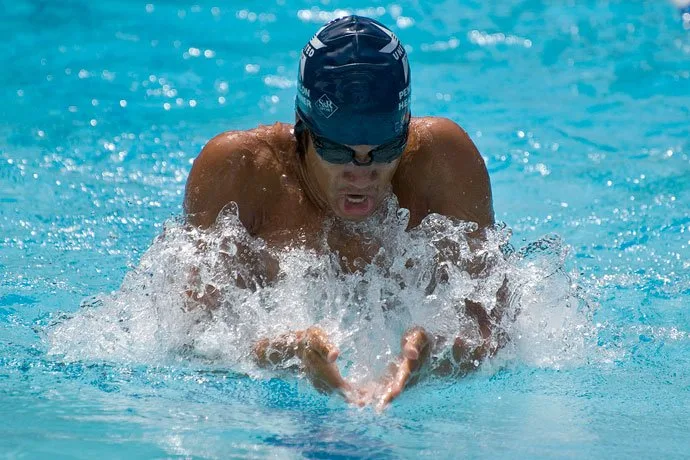This article explains the breathing technique used while swimming breaststroke.
It covers breathing for recreational, fitness and competitive swimmers. It also gives a few additional breathing tips.
Breathing while doing the breaststroke is easy because the head is in a neutral position above water when inhaling, thus leading to fewer difficulties in comparison with other swimming strokes.

How and when you breathe in breaststroke depends on if you keep your head above water at all times, as many recreational swimmers do, or if you submerge your head each with each stroke cycle, like many fitness and competitive swimmers do.
Recreational Swimmers
If you are a recreational swimmer and keep your head above water at all times, you can naturally breathe without constraints.
But it can be interesting to adopt a breathing pattern similar to the one used by competitive swimmers.
To do so, you should inhale during the insweep of the arms and exhale both during the arm recovery forward and during the outsweep.
By adopting this pattern, you won’t have to change your habits if you become serious about swimming and want to switch to the breaststroke style used by competitive swimmers.
Fitness and Competitive Swimmers
If you are more serious about swimming, you most likely are using the breaststroke style of competitive swimmers.
This means that you submerge your head with each stroke cycle and thus synchronize breathing with the different phases of the stroke cycle.
Inhaling occurs during the insweep of the arms when your head and shoulders rise above the water. Exhaling starts when your arms recover forward, and your head and shoulders drop back into the water.
Exhaling then continues during the outsweep of the arms and up to the point where the arms sweep in again.
This means that the exhalation is a long phase that lasts for as long as the face is in the water.
The inhalation, however, is a short phase that starts during the insweep of the arms, as soon as the head and shoulders rise above the water surface and the mouth clears the water.
Additional Tips
You should not hold your breath, as this might make you tenser, which we try to avoid.
If you intend to swim regularly, it’s best not to use the breaststroke style where you keep your head above water all the time.
This is because swimmers using this style also have the habit of looking towards the pool end, and by doing so they are craning their neck. Over time this can lead to neck problems.
You can inhale and exhale through both your mouth and your nose. I typically inhale through both my mouth and my nose. I also exhale first through both my mouth and my nose.
But as soon as I have spit out any water that might have entered my mouth, I close it and exhale only through the nose for the rest of the stroke cycle.
If you have trouble exhaling in the water, you might be interested in practicing the basic breathing exercises described in the breathing while swimming article. Those exercises are designed to get you being used to exhaling under water.
Related Pages
You may also be interested in the following articles that cover the breaststroke’s swimming technique:

fazelyesry
Thursday 11th of April 2019
I swim every day in the ocean, but I caught a cold. I sneeze. How can I avoid this in the future?
Christophe
Sunday 14th of April 2019
Hi,
If you swim in sometimes cold water, you might want to look into neoprene swim suits and caps, which keep you warm.
Pat
Thursday 28th of June 2018
Some swimmers bob up and down during the various parts of the breaststroke. The photos in this piece show head, neck, and shoulders clearing the water during the stroke.
Is this up and down movement productive or should the swimmer try to maintain a more even, horizontal position parallel to the surface?
Christophe
Thursday 28th of June 2018
Hi Pat,
What you are alluding to is the difference between flat style and wave-style breaststroke.
In his book "Swimming Fastest", Ernest W. Maglisho argues that wave-style breaststroke is more efficient, as the less flat position during the recovery allows the swimmer to recover his legs without needing to bend at the hip so much, and conversely needing to push his thighs downward and forward so much, which reduces drag.
There's also a wave propulsion component in the wave style breaststroke which improves average velocity, but to be honest I'd have to read up on that to remember the details.